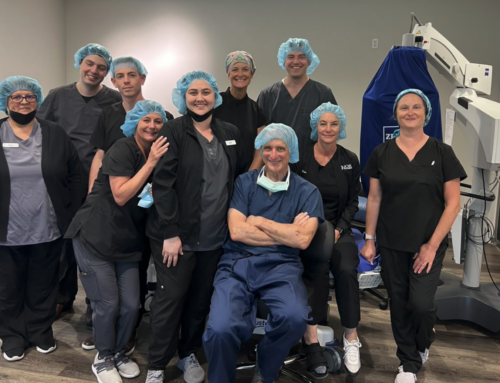
Age-related vision change is something that happens. In fact, it is so common it’s an expected outcome of aging. What you may not realize is that some eye problems can be corrected – or improved – if caught in the early stages. Other vision changes can stem from new or worsening disorders which happen gradually over time. But sometimes vision change occurs suddenly and can cause blindness. Knowing when to see an eye doctor is the best way to preserve good vision for life.
Prevention and Treatment
Perhaps the most common change to vision due to aging is gradual farsightedness. This condition is called presbyopia and almost everyone experiences farsightedness over time. Symptoms start earlier than one might expect; usually sometime in the late-30s to mid-40s. As the lens of the eye loses flexibility it becomes harder to read and to perform other nearby tasks. When presbyopia is left uncorrected, the eyes can tire easily, and this can lead to fatigue and headaches.
Chronic Health Concerns and Vision
Health problems such as high blood pressure and diabetes tend to emerge in people over 40. These diseases can have a negative effect on eye health. Also, an early warning sign of both high blood pressure and diabetes is frequent vision changes. If vision changes due to diabetes or high blood pressure are caught first by an ophthalmologist, then overall health can be improved with a follow up visit to a healthcare provider. At the same time, people with a new diagnosis of diabetes or HBP might want to schedule a visit with the eye doctor to determine a better eyeglass prescription.
Dry Eye
Dry eye is an annoying and uncomfortable problem that also becomes more common with age. Post-menopausal women are more likely than men to have dry eye due to hormonal changes, but men also suffer from more dry eye as they grow older. Dry eye is easily treated with over-the-counter or prescription eye lubricants. But when symptoms of dry eye become severe it is important to speak with an ophthalmologist about possible procedures to help preserve the eyes’ natural tears.
Early Signs of Serious Eye Disease
To maximize eye health and improve the odds of having good vision throughout life, it is very important to get a baseline comprehensive eye exam by the age of 40. An eye exam will help to provide a conclusive diagnosis to determine proper treatment for serious eye problems. These examinations are the only effective way to determine if an eye disease or vision problem is present. An ophthalmologist will look for signs of:
- cataracts
- glaucoma
- diabetic retinopathy
- age-related macular degeneration
Whether or not you have an age-related sight condition, there are simple things that can be done to improve vision and maintain good eye health. It is important to see an eye doctor regularly for comprehensive eye exams and to take special precautions if you have high blood pressure, diabetes or a family history of eye disease.
 Our practice philosophy at Barth Vision & Optical is simple, though we like to think it reflects a profound sentiment. We are here to be of service, in the truest sense of the term. We offer State-of-the-art eye examinations, A unique collection of fashion eye wear, Cataract surgery & consultation, LASIK vision correction, Eye Care Telemedicine. Call Today for an Appointment (707) 955-1120.
Our practice philosophy at Barth Vision & Optical is simple, though we like to think it reflects a profound sentiment. We are here to be of service, in the truest sense of the term. We offer State-of-the-art eye examinations, A unique collection of fashion eye wear, Cataract surgery & consultation, LASIK vision correction, Eye Care Telemedicine. Call Today for an Appointment (707) 955-1120.


